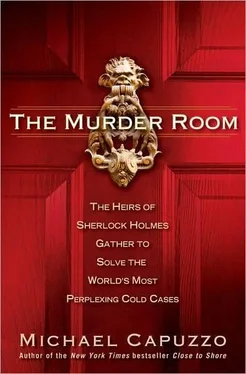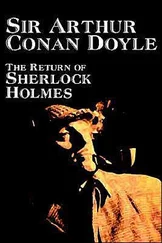While opportunities were nice, Walter kept them focused on reality. “Point A: We didn’t start this for recognition. Point B: We haven’t done anything to deserve recognition. Point C: Journalists are romanticizing us, turning us into heroes, to sell newspapers. Point D: They wouldn’t be able to do this unless there was a real need. It doesn’t matter how they portray us. The fact of the matter is crime is out of control in our society. People need our help.”
The publicity had brought requests flooding into the Vidocq Society’s P.O. box in Philadelphia -in letters, packages, court files, pleas for help, songs of woe. A Los Angeles man wanted the society to investigate his father’s murder, which had occured thirty years earlier. A United States congressman needed confidential assistance to solve a friend’s murder.
The desire to help was animating the whole society. Friel’s return from Texas and the National Organization of Parents of Murdered Children had lit a fire. Fleisher boasted in the Times that the society was a “college of detectives” without equal in the world. Now they had a chance to prove it.
Friel backed his Texas conversion with more than words. It was Friel who persuaded Sergeant Snyder to present Wilson ’s murder before the group for a “fresh set of eyes.” Friel had worked with Snyder in the homicide division in 1984, when Deborah Wilson was killed, and although he didn’t work the case, he and Snyder talked about it often over the years; the college student’s murder still bothered him.
Friel knew what Snyder was feeling, especially toward the end of his career when he was running out of chances. “Bob Snyder is truly a legend in homicide, the consummate homicide detective,” Friel said. “But there are cases you can’t let go of.”
Walter was impressed as he appraised Snyder at the podium. It was an important step that one of the city’s finest detectives had asked for their help. When mobster Frankie Flowers was killed in the Mafia wars, Snyder was the shoe leather the department sent out to find the killer.
Walter felt bad for the hardworking cops, and also for Deborah. He knew how they stewed in a hard boil of grief and rage, haunted by an unanswerable question: Why? There was no rational reason; closure was impossible.
It’s time to out the bastard, he thought. That much I can do.
As Snyder discussed the crime scene, Walter sipped his black coffee and listened.
On the evening of Friday, November 29, 1984, Deborah was working late on a computer project in Randell Hall, a landmark campus building, the detective said. The ornate stone edifice, built in 1901, was a huge labyrinth of classrooms and offices famously difficult to navigate.
At 11 P.M., Deborah called her parents’ home across the river in New Jersey from a computer lab. She said she had to keep working to finish the assignment due the next morning. Gifted at mathematics, her major, Deborah struggled with other courses, including computer science. But she was a disciplined student who put in the long hours needed to excel. She didn’t have a boyfriend, though young men were interested in her, and didn’t smoke or drink. She had modeled and played clarinet in high school but focused on academics in college. Living at home with her parents and commuting to Drexel, she kept her eyes on the future. “She wanted to be an engineer,” her sister Suzanne Leis had said. “She was determined she could do it.” A photograph of a new Mercedes-Benz sedan hung on her bedroom wall as incentive.
Her parents often fretted about their open, trusting, somewhat naïve young daughter working late in the crime-ridden West Philadelphia neighborhood. But Deborah assured them the engineering building was safe, and when she was done she would get a security escort to her car.
Two and a half hours later, at 1:30 in the morning, Deborah called home again and told her parents she still needed another hour to complete the project, but they shouldn’t worry. Her ex-boyfriend, Kurt Rahner, was there with her in the computer room. He’d wait and walk her to her car.
But Rahner didn’t wait. He left the computer room shortly afterward. On his way home, he asked a campus security guard to make sure Deborah got safely to her car, and the guard passed word to campus guard David Dickson. Dickson patrolled the campus on the midnight-to-8 A.M. shift, and was responsible for the computer room.
A few minutes after 1:30 in the morning, Deborah was alone in the lab, working on the computer, when she was attacked. At 1:38 in the morning, computer records show, she made her “last transaction” on the computer. It seemed hurried as if “she was interrupted,” said Drexel computer administrator John J. Gould Jr. “It looked like she stopped in the middle of what she was doing.” Snyder had reconstructed the likely events. Her attacker apparently surprised her and beat her into submission, Snyder said. Then he strangled her to death with an electric extension cord; the cord was discarded near the computer, its grooves matching the marks on Deborah’s neck.
At three in the morning, when her parents hadn’t heard from her, they reassured themselves she was sleeping in the computer room while pulling an all-nighter. In fact, by three in the morning, according to the coroner, she was already dead. In the huge, dark, empty building, her killer carried or dragged her body through the maze of halls and through a door that led to a protected concrete stairwell on the outside of the building. At the bottom of the cold, quiet stairwell on the bitter winter night, he continued to savagely beat her corpse with two bricks, a yard-long piece of lumber, and a strip of metal. The three makeshift weapons were found lying near her body, smeared with her blood.
At nine that morning, two passing students found Wilson ’s body in the stairwell, on a landing eleven steps below street level.
As Snyder spoke, Fleisher passed around additional pictures of Wilson ’s body, a bloodstain found in the computer room and the type of computer she was working on when she died, and the type of sneakers she was wearing. White Reeboks. White socks.
Fleisher joined Snyder at the podium and opened the floor to questions.
“What about the security guard? ” Fleisher himself started it off.
“Dickson was an immediate suspect,” Snyder said. He was the obvious choice. In police interviews, he was shaky about his whereabouts during the course of the evening. But he had an alibi: He told the other guard on duty he’d been talking on the phone with his girlfriend and forgot to escort Wilson to her car. He failed part of a polygraph test, but polygraphs are inadmissible in court. “We never had enough to arrest him,” Snyder said.
The questions came in a torrent.
“Was there a janitor on duty at the time?”
No, Snyder said.
“Were there any arrests for burglary made on campus that night?”
No.
“Have you tried DNA testing?” Heads turned to Halbert Fillinger, the veteran Philadelphia medical examiner. “There may be traces of the killer’s skin nuclei on the cord he used to strangle her if he gripped it tightly enough,” he said. “That residue could be tested for the killer’s DNA.”
Puzzled looks went around the room. DNA testing had not been available when Wilson was killed in 1984; nor was it a well-known technology eight years later. “It’s a long shot,” the Los Angeles Times reporter concluded. “But right now Snyder is willing to clutch on to any suggestion. He’s frustrated by his inability to move the case forward.”
After half an hour, Snyder slumped at the podium. The question-and-answer session was winding down, and he’d gotten little more than free lunch, moral support, and a few interesting ideas.
Читать дальше












